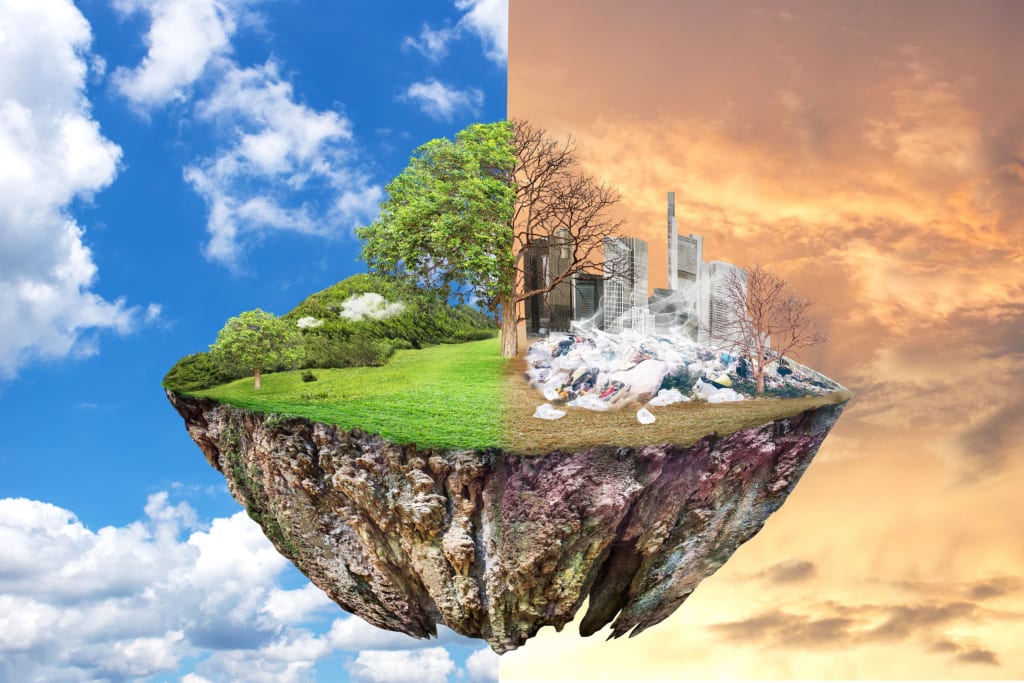Environmental Pollution: Causes, Effects, and Solutions
Environmental Pollution

Environmental Pollution: Causes, Effects, and Solutions
Table of Contents
1. Introduction
2. Understanding Environmental Pollution
• Definition of Environmental Pollution
• Types of Environmental Pollution
3. Causes of Environmental Pollution
• Air Pollution
• Water Pollution
• Soil Pollution
4. Effects of Environmental Pollution
• Impact on Human Health
• Damage to Ecosystems
• Climate Change
5. Solutions to Environmental Pollution
• Reduce Emissions
• Promote Sustainable Practices
• Enhance Environmental Education
6. Conclusion
7. FAQs (Frequently Asked Questions)
Introduction
Environmental pollution is a pressing global issue that poses significant threats to our planet and all forms of life. It refers to the contamination of the natural environment by various pollutants, resulting in adverse effects on the ecosystem, human health, and the overall well-being of the planet. This article aims to explore the causes, effects, and possible solutions to environmental pollution.
Understanding Environmental Pollution
Definition of Environmental Pollution
Environmental pollution can be defined as the introduction of harmful substances or energy into the environment, exceeding the capacity of natural systems to mitigate or neutralize them. These pollutants can originate from various sources, including industrial activities, transportation, agriculture, and improper waste disposal.
Types of Environmental Pollution
Environmental pollution encompasses several types, including air pollution, water pollution, and soil pollution. Each type has distinct characteristics and poses unique challenges to the environment.
Causes of Environmental Pollution
Air Pollution
Air pollution is primarily caused by the release of pollutants into the atmosphere from various human activities. These pollutants include emissions from vehicles, industrial processes, power plants, and the burning of fossil fuels. The accumulation of harmful gases, particulate matter, and toxic chemicals in the air leads to respiratory problems, smog formation, and adverse effects on climate patterns.
Water Pollution
Water pollution occurs when contaminants enter bodies of water, such as rivers, lakes, and oceans. It can result from industrial waste discharge, sewage leakage, oil spills, and excessive use of fertilizers and pesticides in agriculture. Water pollution not only affects aquatic ecosystems but also endangers the availability of safe drinking water for human consumption.
Soil Pollution
Soil pollution arises from the contamination of soil with hazardous substances, including heavy metals, chemicals, and agricultural pesticides. Improper waste disposal, industrial activities, and excessive use of chemical fertilizers and pesticides contribute to soil pollution. This pollution can degrade soil quality, harm plants, and animals, and pose risks to human health through the consumption of contaminated food.
Effects of Environmental Pollution
Impact on Human Health
Environmental pollution has severe consequences for human health. Exposure to air pollutants can lead to respiratory problems, such as asthma and bronchitis, as well as cardiovascular diseases and cancer. Water and soil pollution can contaminate food and water sources, leading to the spread of diseases and long-term health issues.
Damage to Ecosystems
Environmental pollution disrupts delicate ecosystems and negatively impacts biodiversity. Pollution in water bodies can harm aquatic plants and animals, leading to the collapse of ecosystems and loss of species. Air pollution can damage vegetation, affect pollinators, and disrupt the natural balance of ecosystems.
Climate Change
Certain pollutants contribute to climate change by trapping heat in the atmosphere, leading to global warming. The release of greenhouse gases, such as carbon dioxide and methane, from human activities exacerbates the greenhouse effect. Climate change results in rising sea levels, extreme weather events, and disruptions in ecological patterns, posing threats to both humans and the environment as a whole.
Solutions to Environmental Pollution
Addressing environmental pollution requires collective efforts and a commitment to sustainable practices. Here are some solutions that can help mitigate and prevent pollution:
Reduce Emissions
One of the key steps to combat environmental pollution is to reduce emissions of harmful pollutants. This can be achieved by adopting cleaner and renewable energy sources, improving energy efficiency in industries and transportation, and implementing stricter emission standards. Encouraging the use of electric vehicles, promoting public transportation, and adopting green building practices are also effective ways to reduce air pollution.
Promote Sustainable Practices
Promoting sustainable practices is crucial in minimizing pollution and preserving the environment. This includes promoting recycling and waste reduction, encouraging responsible consumption, and supporting eco-friendly agriculture. Governments, businesses, and individuals can work together to implement sustainable waste management systems, minimize single-use plastics, and prioritize the use of organic and environmentally friendly farming methods.
Enhance Environmental Education
Education plays a vital role in raising awareness about environmental pollution and its consequences. By incorporating environmental education into school curricula and conducting public awareness campaigns, we can empower individuals to make informed choices and take actions that contribute to a cleaner and healthier environment. Environmental education can also foster a sense of responsibility and encourage the next generation to become advocates for environmental conservation.
The Importance of Government Intervention
Government intervention is crucial in addressing environmental pollution effectively. Strong environmental policies, regulations, and enforcement are necessary to ensure industries and businesses comply with sustainable practices. Governments can also provide incentives and support for renewable energy development, research on pollution reduction technologies, and the implementation of environmentally friendly practices.
Individual Responsibility and Collective Action
While governments play a vital role, individuals also have a responsibility to contribute to pollution reduction. Small actions, when combined, can have a significant impact. Simple steps such as conserving energy at home, reducing water usage, properly disposing of waste, and choosing eco-friendly products can make a difference. Additionally, participating in local environmental initiatives and supporting organizations dedicated to environmental conservation can help drive collective action toward a cleaner environment.
The Role of Technology and Innovation
Technological advancements and innovation play a critical role in combating environmental pollution. From renewable energy solutions to waste management technologies, innovative approaches can significantly reduce pollution levels. Governments, businesses, and research institutions should invest in the development and adoption of sustainable technologies to mitigate the adverse effects of pollution and promote a greener future.
The Importance of International Cooperation
Environmental pollution knows no boundaries, making international cooperation essential in addressing this global issue. Countries need to collaborate and share knowledge, resources, and best practices to combat pollution effectively. International agreements and protocols, such as the Paris Agreement on climate change, provide a framework for collective action and a commitment to reducing pollution and preserving the environment for future generations.
Conclusion
Environmental pollution poses significant challenges to the well-being of our planet and its inhabitants. Understanding its causes, effects, and solutions is essential in mitigating its impact and creating a sustainable future. By implementing measures to reduce emissions, promoting sustainable practices, and enhancing environmental education, we can work together to combat pollution and ensure a cleaner and healthier environment for generations to come.
FAQs (Frequently Asked Questions)
1. Q: What are the main causes of air pollution? A: Air pollution is primarily caused by industrial emissions, vehicle exhaust, and the burning of fossil fuels.
2. Q: How does water pollution affect marine life? A: Water pollution can lead to the death of aquatic species, disrupt food chains, and harm marine ecosystems.
3. Q: What are some practical steps individuals can take to reduce pollution? A: Individuals can reduce pollution by conserving energy, recycling, using public transportation, and minimizing the use of single-use plastics.
4. Q: How does soil pollution affect agriculture? A: Soil pollution can reduce crop yields, contaminate food sources, and harm beneficial soil organisms essential for plant growth.
5. Q: How can I contribute to environmental education? A: You can support environmental education by participating in awareness campaigns, volunteering for environmental organizations, and sharing knowledge with others.





Comments
There are no comments for this story
Be the first to respond and start the conversation.